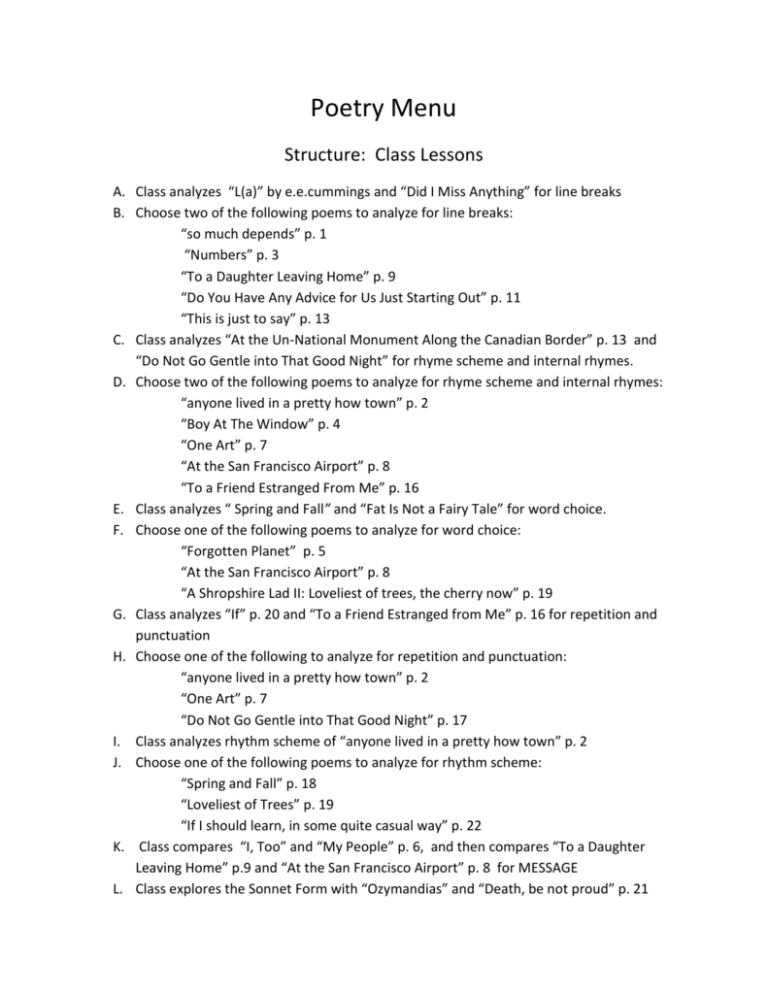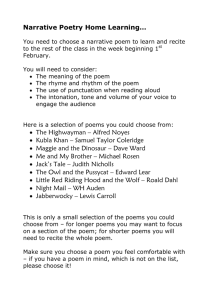Poetry Menu Structure: Class Lessons Class analyzes “L(a)” by e.e.
advertisement

Poetry Menu Structure: Class Lessons A. Class analyzes “L(a)” by e.e.cummings and “Did I Miss Anything” for line breaks B. Choose two of the following poems to analyze for line breaks: “so much depends” p. 1 “Numbers” p. 3 “To a Daughter Leaving Home” p. 9 “Do You Have Any Advice for Us Just Starting Out” p. 11 “This is just to say” p. 13 C. Class analyzes “At the Un-National Monument Along the Canadian Border” p. 13 and “Do Not Go Gentle into That Good Night” for rhyme scheme and internal rhymes. D. Choose two of the following poems to analyze for rhyme scheme and internal rhymes: “anyone lived in a pretty how town” p. 2 “Boy At The Window” p. 4 “One Art” p. 7 “At the San Francisco Airport” p. 8 “To a Friend Estranged From Me” p. 16 E. Class analyzes “ Spring and Fall” and “Fat Is Not a Fairy Tale” for word choice. F. Choose one of the following poems to analyze for word choice: “Forgotten Planet” p. 5 “At the San Francisco Airport” p. 8 “A Shropshire Lad II: Loveliest of trees, the cherry now” p. 19 G. Class analyzes “If” p. 20 and “To a Friend Estranged from Me” p. 16 for repetition and punctuation H. Choose one of the following to analyze for repetition and punctuation: “anyone lived in a pretty how town” p. 2 “One Art” p. 7 “Do Not Go Gentle into That Good Night” p. 17 I. Class analyzes rhythm scheme of “anyone lived in a pretty how town” p. 2 J. Choose one of the following poems to analyze for rhythm scheme: “Spring and Fall” p. 18 “Loveliest of Trees” p. 19 “If I should learn, in some quite casual way” p. 22 K. Class compares “I, Too” and “My People” p. 6, and then compares “To a Daughter Leaving Home” p.9 and “At the San Francisco Airport” p. 8 for MESSAGE L. Class explores the Sonnet Form with “Ozymandias” and “Death, be not proud” p. 21 Content Analysis: Individual Writing Choose A or B A: Which poem is your favorite in the packet? Write a reflection on the poem and why it matters to you, how it affects you. Include specific examples from the poem and from your own life. (About 2 pages long) B: Collect a list of 20 metaphors and images from our packet. Explain in a sentence why each one is effective or ineffective. Choose C or D C: Poetry often deals with social issues. Choose one of the following pairs of poems and issues and write a one-page analysis of how the poem elicits a reaction to a real-life issue. Include specific examples in the poem and how they relate to larger issues in the world. I,Too: Segregation and/or Diversity Ozymandias: The Decline of Fame “If I should learn, in some quite casual way” : Breakups “Domestic Work, 1937”: The Working Class D: Poetry can be about ordinary things. Choose one of the following poems and explain in a one-page analysis what makes the poem “poetic”, even though it uses simple language. “Do You Have Any Advice for Those of Us Just Starting Out?” “Did I Miss Anything?” “This Is Just To Say” Do E E: It is often intriguing to see how different poets approach similar topics. Write an essay comparing two poems. Structure your essay with an introduction, three main paragraphs (each focusing on a different element that both poems share or a way in which they differ), and a conclusion. “When I Heard the Learn’d Astronomer” and “Forgotten Planet” “ One Art” and “To a Friend Estranged from Me” “Do Not Go Gentle Into That Good Night” and “Death Be Not Proud” “Otherwise” and “Loveliest of Trees” “Spring and Fall to a young child” and “Boy At The Window” Creation Whole Class: Writes apology poems Individuals: Choose two of the following prompts to write two poems. A. In the poem “anyone lived in a pretty how town”, e.e.cummings uses sounds, repetitions, rhythm, and unusual word patterns to create a general feeling of childhood. Play around with sounds and rhythm to create a poem about our silly moments in class. B. “If” uses repetition and imagery to give advice to a young boy. Create your own list poem to share wisdom with a friend or younger person. Choose a meaningful order for the list. C. Many of the poems we read deal with loss or change. Come up with your own metaphors from daily middle school life and write a poem on one of these topics. D. Have a go at writing your own sonnet! Remember to have a twist of some sort midway through. E. Create your own anger poem; use unusual line breaks and/or enjambments to symbolize struggles. F. “Domestic Work, 1937” paints a picture of the life of a character. Create your own poem about a specific career or person and show what the person’s life is like through your imagery.









